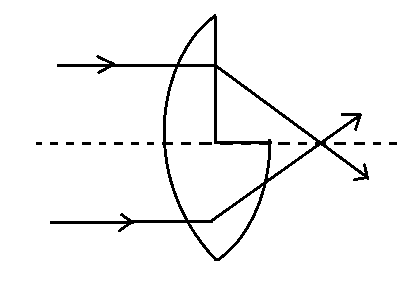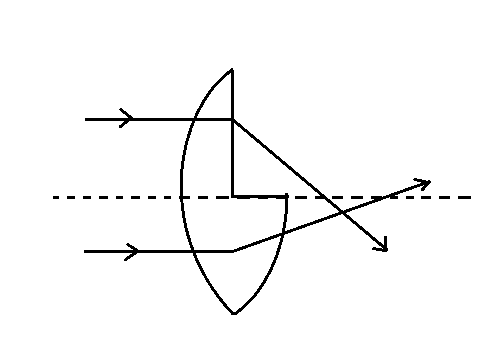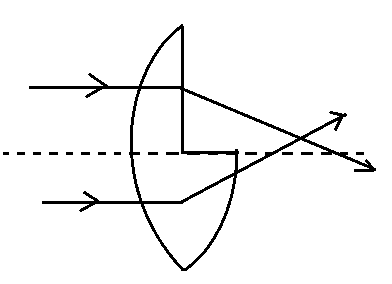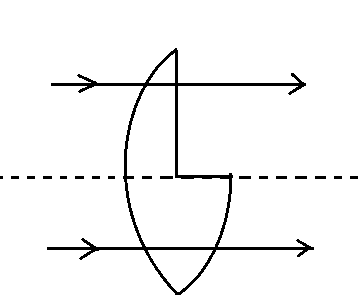
Choose the correct ray diagram of a thin equi-convex lens which is cut as shown in the figure:
A. 
B. 
C. 
D. 
Answer
218.7k+ views
Hint: At the focal point, parallel incident rays converge. In this instance, the focal lengths of the upper and lower halves are different. Since the semi-convex lens in the upper half only has one side plane, it has a longer focal length than the bi-convex lens in the lower half. The intersection of the two rays is now higher on the optical axis because the incident ray from the upper half will converge at a greater distance than the incident ray from the lower part.
Complete step by step solution:
As we know, such data about the equi-convex lens so now let us start the solution of this question. At the focal point, parallel incident rays converge. In this instance, the focal lengths of the upper and lower halves are different. Since the semi-convex lens in the upper half only has one side plane, it has a longer focal length than the bi-convex lens in the lower half.
The intersection of the two rays is now higher on the optical axis because the incident ray from the upper half will converge at a greater distance than the incident ray from the lower part. Therefore, as we get the detail from above, the third structure is the correct answer for this question.
Hence, the correct option is (C).
Note: Now as in this question we get some details about convex lens so now we know some properties of convex lens. A straight beam of light converges through this lens. The center of this lens is thicker, and as we move outward, it becomes thinner.
Complete step by step solution:
As we know, such data about the equi-convex lens so now let us start the solution of this question. At the focal point, parallel incident rays converge. In this instance, the focal lengths of the upper and lower halves are different. Since the semi-convex lens in the upper half only has one side plane, it has a longer focal length than the bi-convex lens in the lower half.
The intersection of the two rays is now higher on the optical axis because the incident ray from the upper half will converge at a greater distance than the incident ray from the lower part. Therefore, as we get the detail from above, the third structure is the correct answer for this question.
Hence, the correct option is (C).
Note: Now as in this question we get some details about convex lens so now we know some properties of convex lens. A straight beam of light converges through this lens. The center of this lens is thicker, and as we move outward, it becomes thinner.
Recently Updated Pages
A square frame of side 10 cm and a long straight wire class 12 physics JEE_Main

The work done in slowly moving an electron of charge class 12 physics JEE_Main

Two identical charged spheres suspended from a common class 12 physics JEE_Main

According to Bohrs theory the timeaveraged magnetic class 12 physics JEE_Main

ill in the blanks Pure tungsten has A Low resistivity class 12 physics JEE_Main

The value of the resistor RS needed in the DC voltage class 12 physics JEE_Main

Trending doubts
JEE Main 2026: Application Form Open, Exam Dates, Syllabus, Eligibility & Question Papers

Derivation of Equation of Trajectory Explained for Students

Hybridisation in Chemistry – Concept, Types & Applications

Understanding the Angle of Deviation in a Prism

Understanding Collisions: Types and Examples for Students

Understanding Atomic Structure for Beginners

Other Pages
JEE Advanced Marks vs Ranks 2025: Understanding Category-wise Qualifying Marks and Previous Year Cut-offs

How to Convert a Galvanometer into an Ammeter or Voltmeter

Understanding Centrifugal Force in Physics

JEE Main Marking Scheme 2026- Paper-Wise Marks Distribution and Negative Marking Details

Degree of Dissociation: Meaning, Formula, Calculation & Uses

Understanding Electromagnetic Waves and Their Importance




